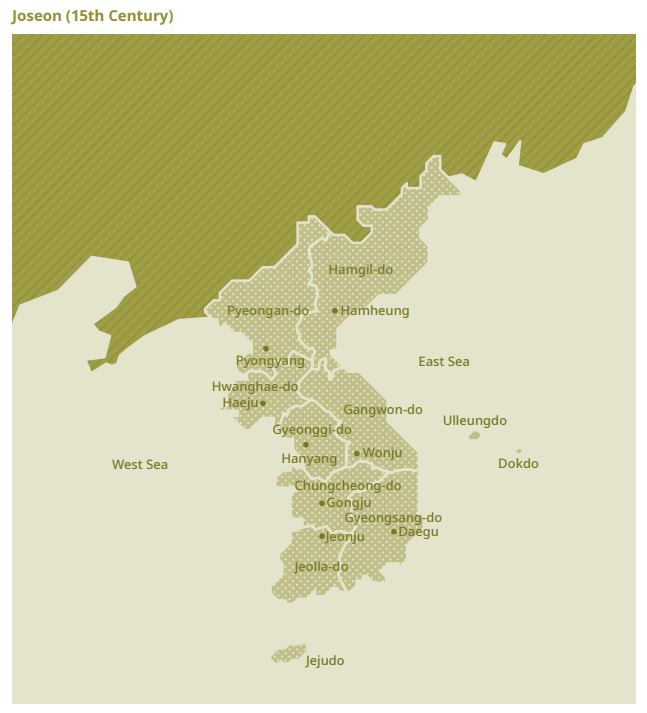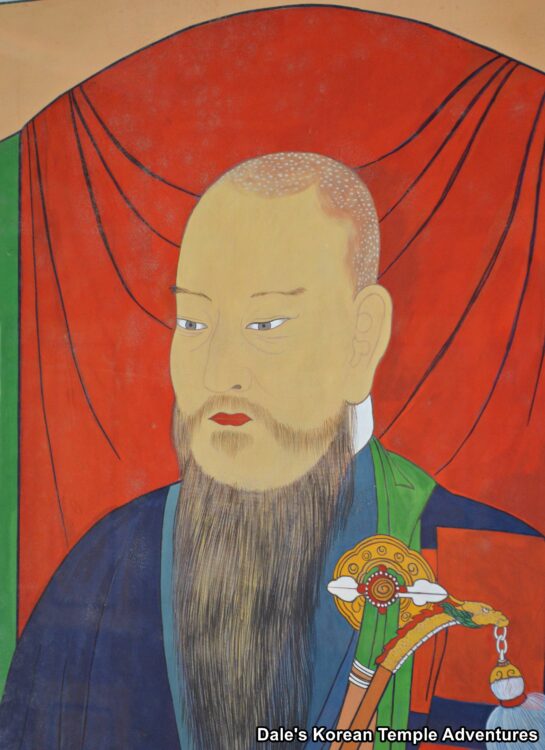The Dark Ages – The Joseon Dynasty (1392-1910)

Early Joseon (1392-1468)
During the Goryeo Dynasty (918-1392), the main purpose behind Buddhism was to ward off natural disasters, protect the nation from foreign invaders, and to bring good fortune to the Korean people. However, at the end of the Goryeo Dynasty, Korean Buddhism had become extremely corrupt both socially and economically. As a result, monks and nuns, as well as temples and hermitages, profited from this corruption. It was due to this corruption that Confucianism and Neo-Confucianism in Korea started to gain ground on Buddhism with court officials. It was in July, 1392 that the Goryeo Dynasty came to an end, and with it, over five hundred years of Joseon Dynasty (1392-1910) rule began. This happened when the Goryeo king, King Gongyang of Goryeo (r. 1389-1392), surrendered his kingship to Lee Seonggye: the future, King Taejo of Joseon (r. 1392-1398). Even though King Taejo of Joseon was raised a Buddhist, he quickly adopted Confucianism as a guiding national ideology. This was done for a number of reasons, but the greatest reason was due to King Taejo of Joseon’s background. As a former Goryeo general who had betrayed his former king to found a new dynasty, it made sense that King Taejo adopted Confucianism as a national ideology. Confucianism at that time focused on a hierarchical structuring of human relationships. And the supreme focus of this structuring was the loyalty towards the king and parents by individuals. With this new form of national ideology, King Taejo of Joseon quickly solidified his reign, but at the expense of Buddhism. However, even though King Taejo of Joseon adopted Confucianism as the national ideology, as supported by Jeong Dojeon (1342-1398), a powerful Confucian minister, King Taejo of Joseon did continue to support Buddhism as seen through the appointment of the royal master, Muhak-daesa (1327-1405), as well as through the continued creation of beautiful new temples and hermitages.
The struggle between Confucianism and Buddhism at this early time in Joseon Dynasty history is best found in the creation of the new Korean capital in Hanyang (present-day Seoul). There are historical records that support this struggle; namely, Dongguk Yegi Bigo:
“There are large rocks on one corner of Mt. Inwangsan, popularly called Seonam [Zen Rocks], because they resemble Buddhist monks in grey hooded habits. Muhak-daesa tried to include them inside the city walls, while Jeong Dojeon [the most powerful Confucian minister at the time] wanted them outside the city walls. Taejo asked for their reasons. Jeong Dojeon said, ‘If they are placed within the city walls, Buddhism will flourish, and if they are put outside, Confucianism will flourish.’ The king ordered to take Jeong Dojeon’s advice.”
With this apparent defeat to Confucianism in the royal court, Korean Buddhism continuously declined and was oppressed throughout the duration of the Joseon Dynasty all but for the briefest of respites.
However, it wasn’t until the reign of King Taejong of Joseon (r. 1400-1418) that the oppression of Buddhism was fully implemented. What this resulted in during his reign was the abolishment of monk participation in politics. Also, temple land reverted back to the Korean government. Additionally, King Taejong of Joseon abolished all but seventy temples that he believed were historically important and significant to the nation. Finally, in 1416, he ordered the Monk Registration System which extremely restricted new monks from joining Buddhist sects in Korea. The Buddhist community retreated to the mountains, where they attempted to make a living off of selling things like paper, oil wood, and straw sandals.

Even the great king, King Sejong the Great (r. 1418-1450), the inventor of the Korean writing system of Hangeul, continued to repress Buddhism. King Sejong the Great actively promoted Confucianism through the creation of such institutions as the Hall of Worthies, or “Jiphyeon-jeon” in Korean, which was a kind of royal academy that promoted the basic principles of Confucianism. And in 1424, King Sejong the Great unified all of the existing eleven sects down to just two: Seon-jong (meditation) and Gyo-jong (doctrinal). King Sejong the Great also prohibited monks from entering castles. However, later in King Sejong the Great’s life, he became less repressive towards Buddhism after the death of the princess. In fact, in 1443, he allowed for the repair and construction of temples that had formally been banned. This brief respite continued under King Sejo of Joseon (r. 1455-1468). This came as a result of King Sejo of Joseon’s deep personal belief in Buddhism. King Sejo of Joseon made great efforts to promote Buddhist culture throughout the Korean peninsula.
Middle Joseon Dynasty (1468-1660)
However, this brief respite didn’t last long with the succession of King Seongjong of Joseon (r. 1494-1506) over his predecessor, King Sejo of Joseon. In 1500, King Seongjong of Joseon closed down twenty-three more temples that housed Buddhist monks. In fact, almost all temples that housed nuns were now closed. The King also did away with the previously established Monk Registration System, which prevented all new people from becoming monks. Additionally, an order was given by King Seongjong of Joseon that all monks had to return to their secular lives. These harsh measures resulted in a countless amount of temples throughout Korea being abandoned and falling into disrepair.
The harsh measures continued under the succeeding King Jungjong of Joseon (r. 1505-1544). In 1509, just four years after taking the throne, King Jungjong of Joseon closed down all the temples found in Seoul and used them for government buildings instead. In that very same year, Confucians flocked to temples to steal Buddhist treasures for which the Confucians received no punishment from the Korean authorities. Things got worse when in 1510, Heughcheonsa Temple was completely destroyed by a fire that had been set by Confucians. At this point in Korean history, Buddhism, at least administratively, became nearly non-existent.
Much like during King Sejo of Joseon’s reign, King Myeongjong of Joseon’s reign from 1545-1567 was a break for Buddhism in Korea. This was in large part due to King Myeonjong of Joseon being too young to reign as king; instead, his mother acted as a regent to the king. In 1551, the king’s mother, who was also a devout Buddhist, reinstated the exam for becoming a monk. However, after the regents’ death, Buddhism was oppressed once more.


One of the most important historical events at this time was the Japanese invasion of Korea, better known as the Imjin War (1592-1598). This occurred during King Seonjo of Joseon’s reign, which lasted from 1567 to 1608. The Japanese general, General Toyotomi Hideyoshi (1537-1598), invaded Busan and the Dongnae castle. They won the southern portion of the peninsula and headed north and westwards. The Korean army was defeated repeatedly. In addition to Joseon society being ravaged by these attacks and invasion, so too were the Korean Buddhist temples and hermitages. It wasn’t until the entry in the war by the Buddhist monk warriors, led by Seosan-daesa (1520-1604) and his student, Samyeong-daesa (1544-1610), that the tides started to turn. It also helped that the Chinese Ming were reinforcing the Korean soldiers. Because Seosan-daesa was too old to fight, Samyeong-daesa joined the Ming Army at the Siege of Pyongyang (1593) and Gaeseong. The military monks and Samyeong-daesa rendered distinguish service at these battles. So while the Confucians hid, it was the socially low-leveled Buddhist monks that defended the nation. Even after the war, Buddhist monks helped restore fortresses, repaired roads, and completed other national reconstruction projects. As a result of Seosan-daesa and Samyeong-daesa’s efforts, Buddhism achieved a brief period of reprieve. At this time in Korean history, Buddhism was largely kept alive through the belief and faith of women.
Late Joseon Dynasty (1660-1910)
With the Imjin War, and the patriotism shown by the army of Buddhist monks known as the Righteous Army, a distant memory, King Hyeonjong of Joseon (r. 1660-1674) once more ushered in an era of political oppression towards Buddhism. In 1660, the first year of his reign, King Hyeonjong of Joseon forbade people from becoming monks, once more. Once again, as though history were repeating itself, he ordered monks to return to their secular lives or else be punished for disobedience. And then, in January, 1661, he brutally closed down Insuwon and Jasuwon, two temples that acted as old age homes for elderly Buddhist nuns. This was then followed up with the reign of King Yeongjo of Joseon (r. 1724-1776). He collected large amounts of money and land from Buddhist temples.
There truly seemed no end or bounds for the repressive nature of the Joseon Dynasty towards Buddhism. Of course there were temporary breaks from this repressiveness, like during King Jeongjo of Joseon’s reign from 1776-1800, when he built his own private temple and had an appeasement policy implemented towards Buddhism. But unfortunately for Korean Buddhism, these respites were few and far between. During the latter stages of the Joseon Dynasty, there were really only two choices left to monks: either they could live a secular life of self-hate because they weren’t practicing the Buddhist faith they believed in, or they could depend on the mystical side of Buddhism found in fortune-telling to make a living. Either way, as the Joseon Dynasty drew to a close, Korean Buddhism was in a dire situation, hardly even existing. It existed only on the very fringes of Korean society, for only Japanese occupation to take place…